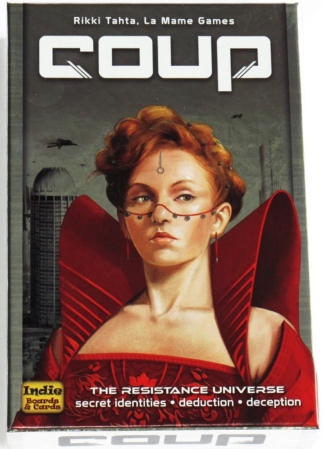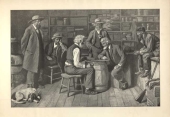The Checker Maven
The World's Most Widely Read Checkers and Draughts Publication
Bob Newell, Editor-in-Chief
Published each Saturday morning in Honolulu, Hawai`i
Contests in Progress:
Cowan's Coup Revisited
Just over five years ago, we published a column on Cowan's Coup based on analysis by Willie Ryan. This week in our Checker School entry, we'll revisit the position and gain the benefit of Ben Boland's viewpoint, as expressed in his classic Famous Positions in the Game of Checkers.

BLACK
White to Play and Draw
W:W24,23,21,20,19,18:B17,14,12,11,10,9.
No matter what move White makes, he's going to lose two men at once. Yet we're asked to find a move that draws.
Is this a coup that you can pull off? Please do try; after all, this is a non-violent coup. But if the solution eludes you, or you'd just like more insight, you can click on Read More to see one way to do it along with numerous sample games and an explanatory note or two.![]()
The Crocodile Position

There's been a lot in the news in recent months about alligators attacking humans, sometimes with tragic results. But crocodiles, particularly the South Pacific varieties, can also be very dangerous.
The differences between crocodiles and alligators are many, even if they seem to be similar creatures. For instance, they have different jaw shapes, and crocs are more tolerant of saltwater environments.
The position below, an entry in our ongoing Checker School series, could be either crocodile or alligator. In fact, as you'll see in our solution notes, it's been called both at various times. But regardless of name, it's quite ferocious.
W. H. RUSSELL
BLACK
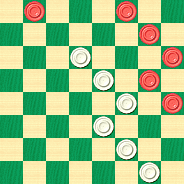
WHITE
White to Play and Win
W:W10,15,19,23,27,32:B1,3,8,12,16,20.
Don't get caught up in the jaws of this one; work it out and then snap your mouse on Read More to see the solution, sample games, and detailed notes.![]()
Capers on the Kelso: Lucky 13
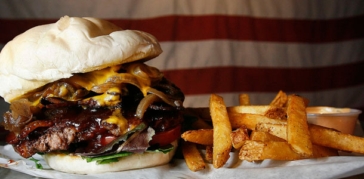
13 is viewed by some as a bit of a "shady" number but we've always liked it. For instance, how can you argue with that great-looking All-American meal above, served by the Lucky 13 Bar and Grill in Salt Lake City?
This is the 13th installment of "Capers on the Kelso" from Willie Ryan's Tricks Traps & Shots of the Checkerboard, and we think you're in luck once again. These pages in Willie's classic book contain an unbelievable wealth of great checker material. Today's position is subtle rather than explosive.
We're still working with Willie's "Variation 3" and in "Note B" of the text we find another fascinating and instructive situation.
Here's the run-up, without commentary.

| 1. | 10-15 | 22-18 |
| 2. | 15x22 | 25x18 |
| 3. | 6-10 | 18-14 |
| 4. | 10x17 | 21x14 |
| 5. | 9x18 | 23x14 |
| 6. | 1-6 | 29-25 |
| 7. | 12-16 | 26-23 |
| 8. | 16-19 | 24x15 |
| 9. | 11x18 | 28-24 |
| 10. | 8-11 | 31-26 |
| 11. | 4-8 | 23-19 |
| 12. | 6-10 |
The correct move here was 6-9. Willie now calls this "a dead loss." Indeed, it is; but White will require patience and technique to bring home the win.
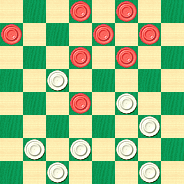
WHITE
White to Play and Win
W:W32,30,27,26,25,24,19,14:B18,11,10,8,7,5,3,2.
You don't need to be lucky to solve this one; although the solution is long, it's not nearly as difficult as some of the others in this series. Try your luck; then, for sure you'll luck out when you click your mouse on Read More to see the solution.![]()
Are You Dunne Drummond Yet?
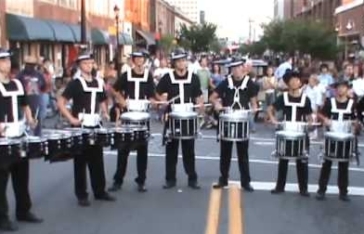
We think you'll agree, when you work through this week's Checker School problem, that it's worthy of an introductory drum roll. There's some very pleasing play involved, and you're sure to get a lot of satisfaction from it. The position is credited to Drummond and Dunne.
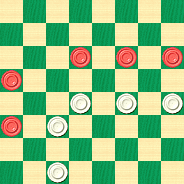
WHITE
White to Play, Black to Draw
W:W30,22,20,19,18:B21,13,12,11,10.
Material may be even, but there are significant mobility issues and things are not so simple. How can Black find the way to a draw?
When the drummer is Dunne Drummond, can you drum up the solution? Work it out and then drum your mouse on Read More to see the solution, along with detailed notes and numerous sample games.![]()
The Return of Mr. Sturges
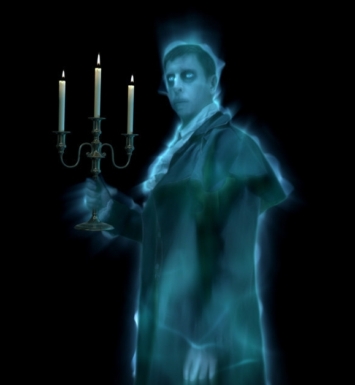
Scare easily?
No, that's not the ghostly apparition of our recent short story; we don't expect Mr. Sturges to return in person any time soon--- or at all, for that matter. But the name and work of such a great player of yore is bound to turn up again and again, and this week is one such instance. Here's a study in our Checker School series which is most unusual, and it's credited to the man himself.
WHITE
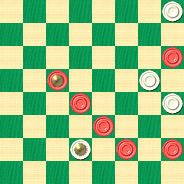
BLACK
Black to Play and Win
B:W29,17,13,K7:B21,K19,15,10,6,5.
You might ask, where's the challenge, with Black up two checkers? Well, he's going to lose one of them right away, and he really needs to watch his step. Certainly, Black has a win, but as is the case in all over the board play, you need to show it.
Phantom moves won't do it. You'll have to play real, solid checkers to save the win. Are you up to the task, or will you be scared off? Don't be afraid; you can always click your mouse on Read More to see the solution, a sample game, and detailed notes.![]()
Capers on the Kelso: An Even Dozen
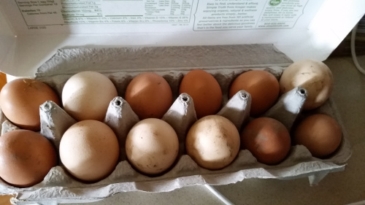
Isn't it curious, in a world dominated by decimal numbers, undoubtedly stemming from our ten finger and ten toe makeup, that the number twelve--- a dozen--- seems to have special meaning? Arithmetic based on twelves is called duodecimal and likely arises from the approximately twelve lunar cycles that make up the solar year.
For us, the significance is that this is the twelfth column in our extended treatment of the Kelso opening, as presented in Willie Ryan's classic Tricks Traps & Shots of the Checkerboard.

We continue to look at Willie's "Variation 3." Here's the run-up.
| 1. | 10-15 | 22-18 |
| 2. | 15x22 | 25x18 |
| 3. | 6-10 | 18-14 |
| 4. | 10x17 | 21x14 |
| 5. | 9x18 | 23x14 |
| 6. | 1-6 | 29-25 |
| 7. | 12-16 | |
The best move to draw remains 26-23, as Willie points out. Last time, we investigated 25-22, which is correctly analyzed by Willie to be a White loss. But what about the closely related move 26-22? Willie comments, "6-9 will do the job." We're not sure quite what Willie meant by "doing the job"; does this move win or merely give White the best winning chances?
| 7. | ... | 26-22 |
| 8. | 6-9 |
Here's the resulting position.
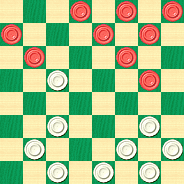
WHITE
White to Play and Draw
W:W32,31,30,28,27,25,24,22,14:B16,11,9,8,7,5,4,3,2.
In fact, there's a draw here, but White has to find it. This is probably another one of those master-level challenges, but as in previous instances, it's worth the effort and there's a lot of technique to be gleaned from a careful study of the position.
It may take more than a dozen minutes, but give it a try, and then click once (not a dozen times) on Read More to see the solution.![]()
Razor Thin
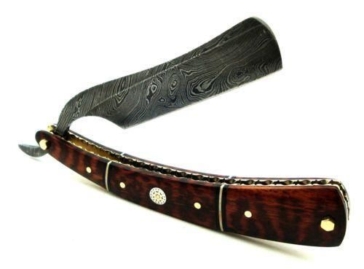
"Razor thin" --- the words describe something so narrow as to be nearly invisible. We're told in recipes to slice our onions "razor thin." Perhaps a basketball team wins by a single point; we say the margin of victory is "razor thin."
In checkers, we refer to "razor thin" advantages and "razor thin" wins or draws. Today's column, part of our Checker School series, asks us to find a "razor thin" draw. Have a look below at a position attributed to the great Wyllie himself.
BLACK
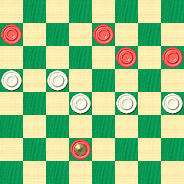
WHITE
White to Play and Draw
W:W13,14,18,19,20:B5,7,11,12,K26.
It may be hard to believe, but White can save the draw here, though it will take "sharp" playing to do so. How "sharp" are you? Can you shave away Black's seeming advantage? Try it out, then cut your mouse over to Read More to see the solution, several sample games, and a collection of explanatory notes.![]()
Reid Along

Having your child read along with you is a wonderfully rewarding activity. We can't say for sure if this mom is sharing a book about checkers with her daughter, but we can certainly hope so.
Today in our Checker School installment, we invite you to a "Reid-Along" of our own, with a problem attributed to checkerist H. Reid.
WHITE
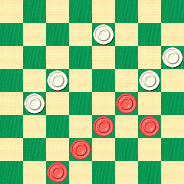
BLACK
Black to Play and Draw
B:W26,21,19,17,16:B14,10,9,7,3.
Can you "Reid" the position and come up with the surprising move that gains Black the draw, or will you "Reid-em" and weep, as the saying goes? Either way, clicking on Reid More (!) will of course bring you to the solution, a sample game, and explanatory notes.![]()
Capers on the Kelso, Part 11

It's hard to believe, but there's still a play on the word "caper" that we haven't used. In many noir movies and detective shows, a "caper" was a crime of particular significance.
Fortunately, checkers is no crime, although you may think a particularly bad move might be one; but that's a pun for another time. Today, we instead turn back to Willie Ryan.

Our extended series on the Kelso moves toward a finish as we start to contemplate Wille Ryan's "Variation 3" as given in his classic book, Tricks Traps & Shots of the Checkerboard. Here's the run-up.
| 1. | 10-15 | 22-18 |
| 2. | 15x22 | 25x18 |
| 3. | 6-10 | 18-14 |
This is the beginning of Variation 3 in the book.
| 4. | 10x17 | 21x14 |
| 5. | 9x18 | 23x14 |
| 6. | 1-6 | 29-25 |
| 7. | 12-16 | 25-22? |
Willie correctly gives 26-23 as the drawing move. He notes that 25-22 gives Black an easier time. In fact, in our KingsRow analysis we quickly discovered that it's a definite Black win.
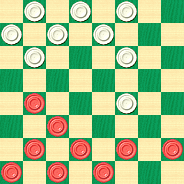
BLACK
Black to Play and Win
B:W32,31,30,28,27,26,24,22,14:B16,11,8,7,6,5,4,3,2.
We may be talking master-level play here, but can you find the Black win? We'll let you know that it's nothing spectacular or fiery, just consistent play that restricts White's options until there are none left. It's the way many a game is won. Can you find the win? As it's said in Hawai`i, "if can, can; if no can, no can." Either way this one is worth some time and effort. When you're done, click on Read More to see the solution.![]()
Master of the Mystic Arts
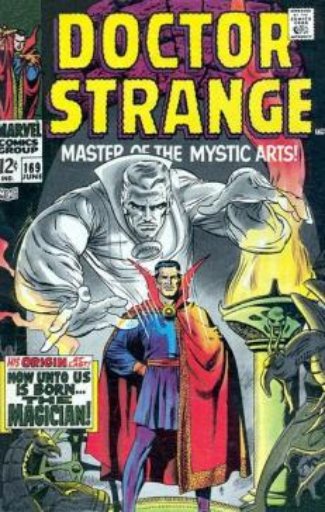
We've written about Julius D'Orio before; his book, Mysteries of Dama, is as entertaining and unusual a checker book as can ever be found. Mr. D'Orio is indeed something of a "Dr. Strange" character, but is he a master of the mystic arts? Can checker lore be ascribed to such a domain?
We can't give a definitive answer to that question, but we can say that today's Checker School lesson, taken from Ben Boland's Famous Positions in the Game of Checkers, features the colorful Mr. D'Orio once again.
The problem position is indeed intriguing.
BLACK
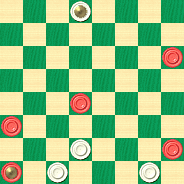
WHITE
White to Play and Win
W:W32,30,26,K2:BK29,28,21,18,12.
White, a man down, can still win. But how? What is the mystical series of moves that allows White to defeat the odds and bring home a victory?
Incantations are not necessary, just solid over the board skills. Give it a try and then wave your magic mouse on Read More to see the solution, notes, and a very instructive sample game.
[Read More]The Checker Maven is produced at editorial offices in Honolulu, Hawai`i, as a completely non-commercial public service from which no profit is obtained or sought. Original material is Copyright © 2004-2025 Avi Gobbler Publishing. Other material is the property of the respective owners. Information presented on this site is offered as-is, at no cost, and bears no express or implied warranty as to accuracy or usability. You agree that you use such information entirely at your own risk. No liabilities of any kind under any legal theory whatsoever are accepted. The Checker Maven is dedicated to the memory of Mr. Bob Newell, Sr.
